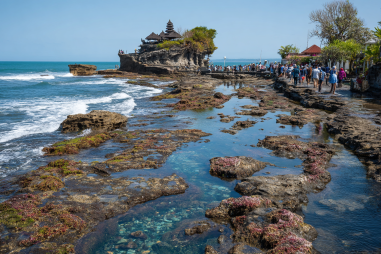Bali is renowned for its rich cultural heritage and deeply spiritual traditions, most notably expressed through its numerous temples and the vibrant festivals celebrated at these sacred sites. Among these, Tanah Lot Temple stands out not only for its stunning sea-facing location but also for its important role in local religious life. To truly appreciate the essence of Bali’s culture, understanding the festivals and ceremonies held at Tanah Lot Temple offers a fascinating glimpse into the island’s communal spirit and age-old customs.
Overview of Balinese Temple Festivals
Balinese temple festivals, known locally as “Odalan,” are grand celebrations that honor the gods and ancestral spirits believed to reside in the temple. These festivals are integral to maintaining harmony between humans, nature, and the spiritual world. Each temple celebrates its Odalan every 210 days, following the Balinese Pawukon calendar, and these events are marked by elaborate rituals, colorful decorations, traditional music, and dance performances.
Temples across Bali serve as centers for community gatherings during these festivals, offering locals and visitors alike a chance to witness the island’s distinctive blend of spirituality and artistry. Festivals emphasize gratitude, purification, and protection, and often involve offerings, prayers, and communal feasts that strengthen social bonds.
Important Ceremonies Unique to Tanah Lot
While Tanah Lot participates in the standard Odalan celebrations every 210 days, it is also known for several unique ceremonies owing to its status as a sea temple. One of the most important is the “Melasti” ceremony, traditionally held several days before the Balinese New Year (Nyepi). Melasti involves a procession to the sea where sacred objects from the temple are cleansed in the ocean to purify and wash away spiritual impurities.
Another distinctive ceremony is the “Piodalan” ritual at Tanah Lot, characterized by offerings that honor the powerful sea spirits believed to protect the temple and the island’s shores. This ceremony includes chanting by temple priests, traditional gamelan music, and intricate dance performances that narrate mythological stories connected to the temple’s origin.
Timing and Activities of Each Major Festival
Understanding when and how these festivals unfold helps visitors plan their trips around the most immersive experiences. The main festivals at Tanah Lot usually correspond with key dates in the Balinese Pawukon calendar, especially:
- Piodalan Festival: Occurring every 210 days, this festival marks the temple’s anniversary. Activities include processions of offerings, prayers, and vibrant dance shows at sunset.
- Melasti Ceremony: Held a few days before Nyepi, this cleansing ritual features a dramatic parade from the temple to the sea, with worshippers carrying sacred temple artifacts, holy water, and offerings to the beach for spiritual purification.
- Nyepi Day: Although a day of silence observed island-wide, the day before Nyepi, known as “Ngembak Geni,” sometimes involves visits to Tanah Lot to partake in blessing rituals.
During these festivals, the temple and its surroundings burst with life from the early morning through sunset, creating a magical atmosphere full of spiritual energy and cultural display.
How Locals and Tourists Participate
Participation in Tanah Lot’s festivals is a deeply communal affair for locals, and visitors are warmly welcomed to observe and sometimes join in respectful ways. Balinese people prepare weeks in advance, crafting meticulous offerings from flowers, rice, and palm leaves. Wearing traditional clothing is common, symbolizing respect and devotion.
Tourists can join by:
- Observing the ceremonies quietly and respectfully, minimizing disruptions to worshippers.
- Participating in cultural workshops arranged by local guides to learn about the significance of the offerings and rituals.
- Purchasing traditional attire from nearby markets to wear during the festivals, enhancing cultural immersion.
- Engaging with locals to ask about the symbolism and stories behind the dances and rituals.
Preparation and Offerings Involved
The preparation for festivals at Tanah Lot reflects the Balinese dedication to maintaining spiritual balance. Offerings, known as “canang sari,” are handcrafted daily but during festivals become far more elaborate. These offerings often feature a vibrant combination of incense, flowers, fruits, and symbolic items laid out in intricately woven coconut leaf trays.
Preparations also include cleaning the temple grounds, decorating with colorful banners and umbrella-like structures called “tedung,” and rehearsing traditional dances. Priests consecrate the offerings early in the morning in special rituals invoking blessings from the gods and ancestors.
Every element, from the choice of colors to the placement of offerings, carries deep spiritual meaning, aiming to appease the deities and secure prosperity and protection for the community.
Photography and Visitation Tips During Events
For visitors wanting to capture the beauty and spirituality of Tanah Lot festivals, here are some friendly tips to ensure a respectful and enjoyable experience:
- Respect privacy: Always ask permission before photographing individuals, especially during intimate rituals.
- Dress modestly: Wear clothing that covers shoulders and knees to respect local customs, often available for rent near the temple.
- Arrive early: Festivals attract large crowds, so arriving early helps secure a good viewing spot.
- Use a zoom lens: Allows capturing details without disturbing the ceremonies up close.
- Follow guidance: Pay attention to signs and instructions from temple officials to avoid restricted areas.
- Stay hydrated and sun-protected: Events can last several hours outdoors under the sun.
By following these tips, visitors not only capture memorable images but also honor the spiritual ambiance of the celebrations.
Embracing the Spirit of Tanah Lot
Attending the festivals and ceremonies at Tanah Lot Temple opens a window into Bali’s soul, where faith, tradition, and community intertwine beautifully. Whether witnessing the solemn purification of Melasti, joining the joyful dance performances, or simply soaking up the vibrant atmosphere, visitors find themselves drawn into a living tapestry of culture and devotion.
These celebrations are more than just visual spectacles; they exemplify the Balinese philosophy of harmony and respect for the unseen forces that shape life. By embracing these moments with open hearts and minds, both locals and tourists contribute to the preservation and celebration of Bali’s timeless heritage.







